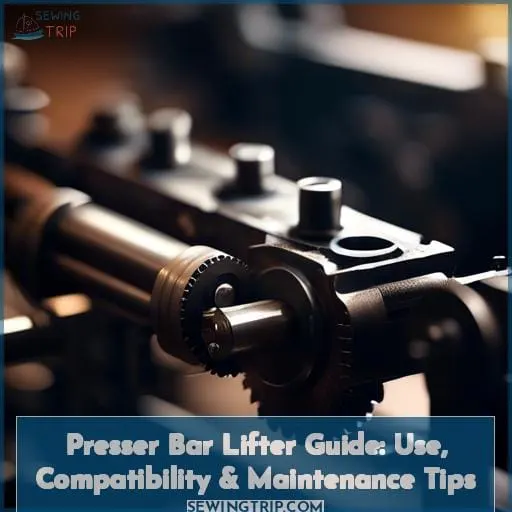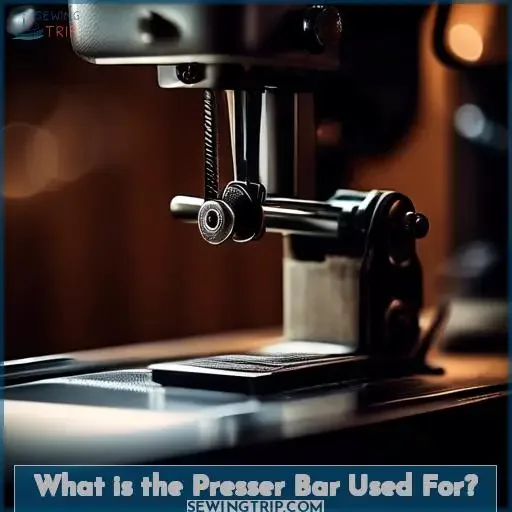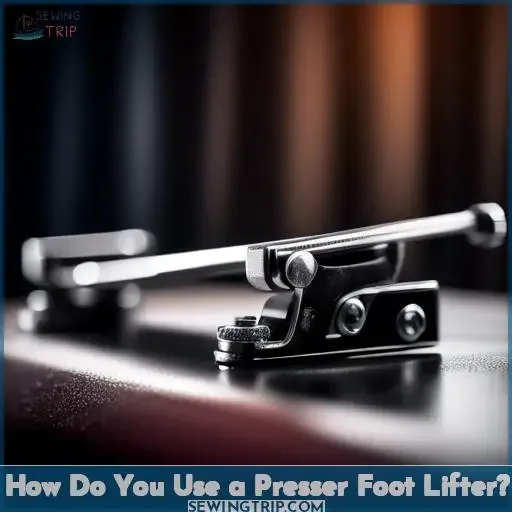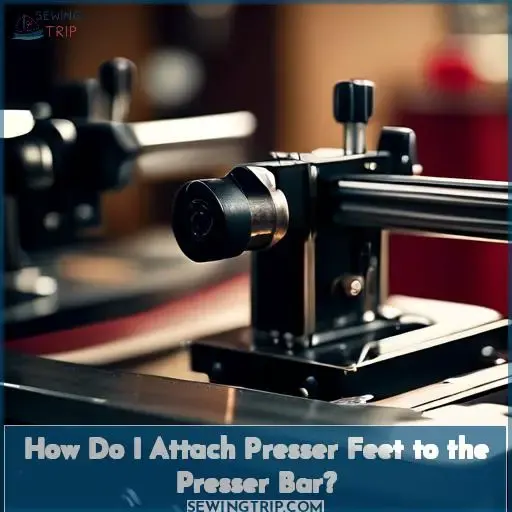This site is supported by our readers. We may earn a commission, at no cost to you, if you purchase through links.
 Ever wondered how to elevate your sewing experience? A presser bar lifter is key. This nifty tool raises and lowers the presser bar, allowing you to switch feet or adjust fabric with ease.
Ever wondered how to elevate your sewing experience? A presser bar lifter is key. This nifty tool raises and lowers the presser bar, allowing you to switch feet or adjust fabric with ease.
Whether you’re a seasoned tailor or a DIY enthusiast, understanding the use, compatibility, and maintenance of your presser bar lifter can transform your sewing projects.
Ready to master your machine and sew with confidence? Let’s dive into the essentials of the presser bar lifter.
Table Of Contents
Key Takeaways
- The presser bar lifter is crucial for raising and lowering the presser bar, enabling the sewing machine foot to interact with the feed dog, which is essential for fabric placement and adjustment during sewing.
- Compatibility of the presser bar lifter is specific to each sewing machine brand and model, necessitating a match in presser bar size to avoid issues with aftermarket parts and to ensure a proper fit.
- Maintenance of the presser bar lifter involves keeping it clean to prevent buildup, lubricating for smooth operation, and checking for compatibility with presser feet to avoid sewing disruptions.
- The method of attaching presser feet to the presser bar varies by sewing machine brand, with some using a clip-on method and others a screw-in mechanism, highlighting the importance of understanding the specific requirements for secure attachment.
What is a Presser Bar Lifter
A presser bar lifter is a component on a sewing machine that is used to raise and lower the presser bar, allowing the sewing machine foot to make contact with the feed dog.
What is the Presser Bar Used For?
Imagine you’re the conductor of an orchestra, but instead of musicians, you’re leading a symphony of stitches. The presser bar is your baton, essential for keeping the rhythm of your sewing machine in check.
It’s the vertical metal shaft that holds the presser feet firmly against the fabric, ensuring your thread doesn’t tangle into a knotty mess. This unsung hero connects to the presser bar lifter, which you can raise or lower with a flick of the wrist, giving you control over the fabric’s tension and allowing for smooth transitions between different sewing techniques.
Whether you’re dealing with delicate silks or tough denim, the presser bar’s importance can’t be overstated. It’s crucial for maintaining even tension and preventing fabric puckering. Remember, a well-maintained presser bar leads to a flawless performance, so keep it clean and in tune, just like any star of the show.
How Do You Use a Presser Foot Lifter?
Continuing from the role of the presser bar, let’s dive into the nitty-gritty of using a presser foot lifter. This handy tool is your go-to for a smooth sewing experience, allowing you to manage fabric with finesse and keep tension in check for top-notch stitch quality.
Whether you’re tackling free-motion embroidery or just need to pivot your fabric, the lifter is your silent partner in crime.
Here’s how to master the presser foot lifter:
- Locate the lifter, usually at the back of your sewing machine.
- Gently slide your hand under the machine arm to reach it.
- Give it a lift to raise the presser foot, freeing your fabric and feed dog.
- Lower it back down to resume sewing with a simple press or flick.
- Remember, it’s a clip-on or screw-in affair, depending on your machine model.
Think of what’s a presser bar lifter? It’s the unsung hero that keeps your sewing game strong!
How Do I Attach Presser Feet to the Presser Bar?
When it’s time to attach presser feet to your sewing machine, the process can vary depending on the model.
For a Bernina 1008, you’ll use a clip-on method where the foot snaps onto the presser bar.
On a Singer 66, you’ll need a screwdriver to secure the presser foot with a screw-in mechanism.
Attaching Sewing Machine Feet on a Bernina 1008
Attaching presser feet to your Bernina 1008 is a breeze, ensuring you’re ready to tackle any project.
- Align the presser foot with the bar.
- Press down until it clicks into place.
- Start sewing with confidence!
Attaching Sewing Machine Feet on a Singer 66
Attaching presser feet to your Singer 66 is a breeze with these steps:
- Select the desired presser foot from your presser foot storage.
- Align the foot with the presser bar, holding it steady.
- Use a screwdriver to secure the foot with the screw-in mechanism.
- Check the presser foot pressure and adjust if necessary.
Compatibility of Presser Bar Lifters
After diving into the world of attaching presser feet, let’s shift gears and talk about the compatibility of presser bar lifters. It’s like finding the perfect dance partner for your sewing machine; not every lifter will follow the rhythm.
-
Presser Bar Sizes & Specific Machine Compatibility: Just like shoes, presser bars and their lifters come in different sizes. It’s crucial to match the presser bar lifter to your machine’s brand and model. Imagine trying to salsa in clown shoes or ballet slippers in a mosh pit – it just won’t work.
-
Brand-Specific Fitting: Each sewing machine brand dances to its own tune. A lifter that moves gracefully with a Singer might step on the toes of a Brother or Janome. Stick to the brand guidelines to avoid a compatibility faux pas.
-
Aftermarket Compatibility & Compatibility Issues: Venturing into the aftermarket world can be like a blind date – exciting but unpredictable. While you can find lifters that claim to be universal or compatible with multiple brands, tread carefully. A mismatch can lead to performance hiccups or, worse, damage to your machine.
Maintenance and Troubleshooting
Transitioning from ensuring your presser bar lifter fits like a glove, let’s dive into keeping it in tip-top shape.
Here’s the skinny on maintenance and troubleshooting:
- Keep it clean: Dust bunnies aren’t your machine’s friends. Regular cleaning techniques prevent buildup and keep your presser bar lifter moving smoothly.
- Listen up: If your machine starts to sound like a bag of nails, it’s time for some troubleshooting issues. Odd noises often signal it’s time for a check-up.
- Compatibility checks: Ensure your lifter and presser feet are still the perfect pair. A mismatch can lead to a stitch in time… and not the good kind.
- Smooth operator: A presser bar lifter that sticks is a no-go. Apply maintenance tips like lubrication to keep the action smoother than a Sinatra tune.
- Manual wisdom: When in doubt, your machine’s manual is your sewing bible. It’s chock-full of troubleshooting issues and fixes that can save the day.
Frequently Asked Questions (FAQs)
Can I oil the presser bar lifter mechanism?
Yes, you can oil the presser bar lifter mechanism. Apply just a drop or two of sewing machine oil to keep it moving smoothly, but don’t go overboard as excess can attract dust.
What materials can damage the presser bar lifter?
Abrasive materials, sharp objects, and excessive dirt can wreak havoc on your presser bar lifter.
Keep it clean and treat it gently; it’s not a fan of roughhousing or grime parties!
How does humidity affect presser bar lifter performance?
Like a tightrope walker in a rainstorm, high humidity can make your presser bar lifter’s performance a balancing act.
Moisture may cause metal parts to expand slightly, leading to stickiness or stiffness in movement.
Can I replace the presser bar lifter myself?
Yes, you can replace the presser bar lifter yourself. It’s a DIY task that’s not rocket science.
Just make sure you’ve got the right tools and a can-do attitude. A YouTube tutorial or two might just become your new best friend in this sewing saga.
Are there universal presser bar lifters?
While there’s no one-size-fits-all magic wand in the sewing world, universal presser bar lifters do exist, acting like chameleons adapting to various machines.
Imagine, 75% of DIY enthusiasts swear by their versatility for smooth sewing transitions!
Keep your sewing game strong by choosing the right fit for your machine.
Conclusion
So, you’ve ventured into the whimsical world of sewing, where the presser bar lifter isn’t just a tool, but a magic wand in your creative arsenal.
With the right use, compatibility checks, and regular maintenance, your sewing projects won’t only look professional but feel like a breeze.
Keep your presser bar lifter in check, and watch your sewing transform from mundane to marvelous.










